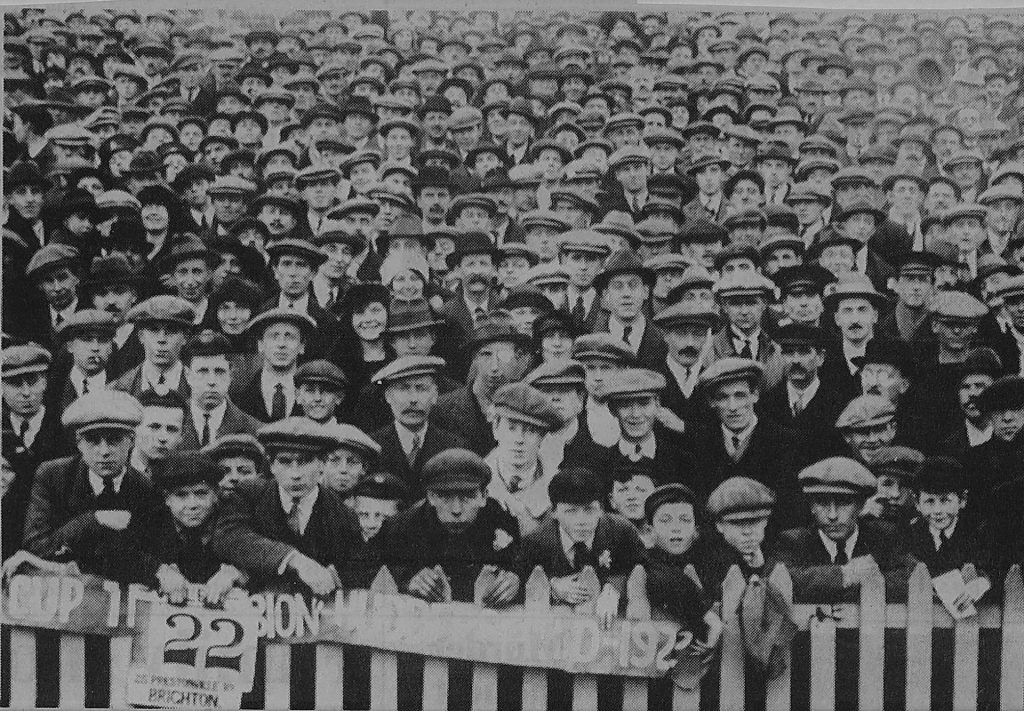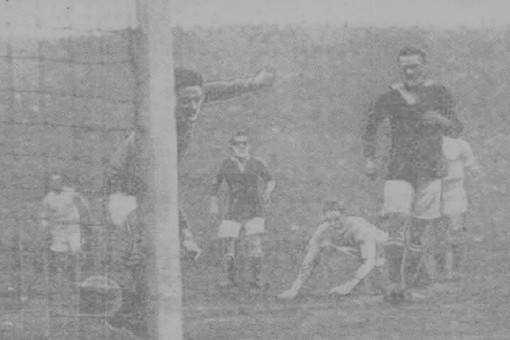Written for Huddersfield Town Supporters’ Association Heritage Project
On the morning of 19th September, 1914, German artillery shells pierced the lead-covered roof of Rheims Cathedral, setting fire to the underlying timber.
The resulting damage to such an iconic, holy building incensed the French, and for the rest of the war, its fractured silhouette stood as a metaphor for Teutonic aggression or the futility of armed conflict, depending on one’s politics.
After the armistice, renowned architect Henri Deneux was tasked with restoring the cathedral to its former glory. But by early 1922, the project had run out of funds.
So, in the spirit of the Entente Cordiale, British diplomat Victor Cavendish-Bentinck proposed a solution of sorts. His plan was to arrange a series of football matches between France’s women’s team and various English women’s clubs, including the popular Dick, Kerr Ladies. The gate receipts would be donated to the Archdiocese of Rheims to underwrite Deneux’s renovation.
There was just one problem: The FA had effectively banned women’s football in December of 1921 and appeared unwilling to make an exception for Cavendish-Bentinck’s scheme. Presumably, they were still convinced by their initial justification for imposing the ban – that kicking a ball around a field was “quite unsuitable for females” because it might affect their “frame” and fertility.
The captain of Huddersfield Atalanta Ladies, Lucie Barraclough, disagreed. With her tongue firmly in cheek, she told a newspaper that the F.A.’s reasoning was nonsense.
“If football were dangerous some ill-effect would have been seen by now,” she said. “I know that all our girls are healthier and, speaking personally, I feel worlds better than I did a year ago.
“Housework isn’t half the trouble it used to be, because there is always Saturday’s game and the weeknight training to freshen me up.”

The people of Huddersfield seemed to concur. In 1921, 15,000 spectators watched Atalanta beat Bath Ladies 1-0 at Leeds Road, while nearly 9,000 flocked to the Fartown Ground to see them face a touring French XI. By all accounts, the men’s players were eager to back Atalanta, too.
Forward Ada Beaumont later recalled that the two sides even trained together and said: “The fellas were smashing. They would take the girl who played in their position and try and teach them.
“There was a good centre-half who took my sister under his wing. We made a good team up that way. I trained with Billy Smith, the international. They all did it voluntarily, but they seemed to enjoy it, and so did we.”
Preparations
Alas, Smith and his teammates had to settle for one another’s company as they prepared for their third round FA Cup tie away at Blackburn Rovers. There was, however, the small consolation of a trip to Lytham St Annes. An Examiner report dated 17th February, 1922, a day before the game, paints a serene picture:
“The Town players have been following their usual course at Blackpool during the week. They have had walking and golfing exercises, and a little training with William Norman’s [Blackpool F.C.] players [at Bloomfield Road].”
Notwithstanding Town’s recent poor form in the league, the West Riding press was confident that their guile and determination would be enough to overcome Rovers, who were struggling in the First Division themselves. Ahead of the clash, the Leeds Mercury’s football correspondent explained why he thought Town were a good bet in surprisingly effusive terms.
“Huddersfield Town hardly could have given a more convincing exhibition of the resources, strength, and stamina which is required to win an exacting game than when they accomplished the downfall of Burnley. They were a typical cup-fighting force. Unlike many of the pattern weaving, scientific combinations in first-class football they have the knack for adapting themselves to the conditions and the quality of the opposition; and their stamina is a decisive asset.”
Writing in a syndicated column published on the morning of the game, Town talisman and two-time F.A. Cup winner Clem Stephenson was slightly more circumspect, though no less optimistic, in his analysis.
“The cup is essentially a lucky competition,” he wrote. “By that I do not mean to suggest that a ‘dud’ side can lift the trophy if it has a lot of luck, but I do suggest that what we call luck plays an important part in the cup.
“One stray shot from the boot of a forward may win a cup-tie, and one slip by a full-back or a goalkeeper may put an end to all hopes for that particular side for a season.”
READ MORE: Former Huddersfield Town striker Marcus Stewart looks back his time at the club.
Blackburn also fancied their chances, and for similar reasons. The arrival of new manager Jack Carr at the beginning of the month was followed by two shock victories over title-holders Burnley, which promptly revived enthusiasm for the team among fans and Lancashire journalists alike.
In the run up to the cup game, the latter were particularly fond of pointing out that Rovers had beaten Herbert Chapman’s men 2-0 in their last meeting on home turf, conveniently ignoring the fact that Town triumphed 3-0 in the reverse fixture.
Together with a general fondness for War of the Roses analogies, the parity between the two sides made their tie the most anticipated of the entire round. Indeed, demand for tickets was so high that the Blackburn directors said they expected to welcome a historic crowd to Ewood Park on Saturday afternoon. To satisfy the public’s interest, travel operators organised day trips via car and rail from as far afield as Manchester, Liverpool, and Bradford.

Attempt Number One (For the Third Time)
In the end, the record books remained untouched.
Even so, an impressive 45,068 people crammed into the stadium in time for kick-off, a significant number of whom hailed from the other side of the Pennines.
Aside from wearing red shirts, Town lined-up in familiar fashion. Davis started in goal behind full backs Wood and Wadsworth. Wilson sat in the middle, with Watson to his left and Slade to his right. Smith was on the left wing, while Richardson was selected on the right wing. Mann played at inside left, Stephenson occupied the inside right, and Islip persisted up front.
Blackburn matched them man for man: Ronald ‘Ronnie’ Sewell in net; David Rollo and Tom Wylie in defence; Henry Healles, Frank Reilly, and Levy Thorpe in midfield; and Archie Longmuir, Norman Rodgers, Percy Dawson, Johnny McIntyre, and Joe Hodkinson in the forward positions.
Much to the disappointment of the home fans, Rovers matched little else in the opening exchanges. Town began brightly. They passed the ball with pace and purpose, controlling the tempo of the game, and launching wave after wave of attack to no reply. This endeavour was duly rewarded on 40 minutes, when Mann picked up the ball near the centre circle, before driving past Rollo and Wylie at great speed. He then smashed it into the net with his favoured left foot. According to the Daily Herald, Sewell “had no possible chance of stopping it.”
The second half was a more even affair. Blackburn proved effective at closing down Wilson and keeping the visitors’ wingers quiet. They also saw more of the ball and created several good chances, culminating in a Hodkinson goal in the 64th minute to level the score.
Soon thereafter, though, Wadsworth spotted Sewell in no man’s land and attempted an ambitious lob from around 50 yards. To the astonishment of everybody, including Wadsworth himself, the ball sailed over the wrongfooted keeper, who scrambled to scoop it back into play.
Or not, as it turned out. One reporter recounted the confusion: “All the Town players appealed. The referee consulted a linesman – the one who was in the worst place to see the position of the ball – and disallowed [it]. I understand that after the match Rollo, the Rovers right back, commiserated with Wadsworth on the misfortune, and admitted that the ball was well in the net.”
Frustrated, but not discouraged, Town kept up the pressure. With ten or so minutes to go, Smith received the ball on the left flank near the byline and whipped a low cross into the box. Islip found his way onto the end of it.
Until, that is, the flag went up for offside. The players once again disputed the decision, protesting that a Rovers defender had touched the ball before it reached Islip. The referee was unmoved, though numerous match reports subsequently sided with the men in red.
Despite Town’s best efforts, the scoreboard read 1-1 at the final whistle. The result was so controversial that some fans even raised the spectre of match-fixing.
The Examiner was quick to dismiss such accusations, but agreed that the officials had spoilt the day saying: “Huddersfield Town were very fortunate in not bringing away a win in the third round of the F.A. Cup…They won the match, but were not allowed to gain the verdict.”
As Stephenson had predicted, “luck plays an important part in the cup.” It just so happened that Blackburn enjoyed all of it on this occasion.
Attempt Number Two (For the Third Time)
Another draw meant yet another Wednesday afternoon replay at Leeds Road—the third in six weeks.
Smith was forced to miss an international trial scheduled to take place at Fulham, and local mill owners were no doubt irritated at the prospect of further absences and closures. Many inhabitants of the town, however, were happy to watch more cup football, especially if they could finish work early. In fact, 31,899 of them braved strong gales to do so.
Their team encountered some minor transport difficulties on the Tuesday night, forcing them to stayover in Leeds and taxi over to Huddersfield in the morning. More encouragingly, A. W. D. Fowler, who officiated the first leg, withdrew from the game “owing to business engagements.”
The Yorkshire Evening Post assured its readers that his absence had “nothing to do with the incident[s] which, in Huddersfield’s opinion, deprived them of success at Ewood Park.” The teams, in contrast, were unchanged.
Town won the toss and opted to play with the wind at their backs. Chapman seems to have instructed his midfielders to use the elements to their advantage by punting long balls out to the wings. This tactic paid off almost immediately, with Mann and Stephenson able to create havoc in the final third, largely due to the accuracy of Wilson’s passing. For their part, Blackburn were slow, ponderous, and unenterprising from the start. They repeatedly failed to track Town’s forwards and showed no sign of troubling Davis.
The first goal was a foregone conclusion, arriving after ten minutes. Some clever interplay between Smith and Islip made space for Mann, who finished with a piledriver. The second came when Blackburn bungled a Smith corner, leaving Islip to convert from a few yards out. Smith scored the third directly from a free kick.
3-0 to Town after half an hour.
Half time provided only a brief respite for the Lancastrians. Smith scored from close range just three minutes after the interval, though Mann deserved much of the credit, having beaten Wylie and then duped Rollo by passing instead of shooting. Stephenson and Smith combined to set up Islip for the fifth.
5-0 to Town on the 70-minute mark. And that’s how it stayed.
The papers criticised Blackburn’s “farcical” defending but made it clear that the Town were the architects of their own success, praising them for displaying “admirable teamwork, the utmost confidence, and irrepressible dash.”
The only point of discussion was the margin of victory. The Examiner claimed that “if the Town forwards, and Wilson also, had taken all their chances the score would have been ten goals instead of five.” The Mercury, on the other hand, adopted a more conservative tone, stating that “it might have been seven.”
At any rate, luck didn’t come into it.
F.A. Cup Third Round
18th February, 1922
Ewood Park, Blackburn — 45,068 attendance — £3,360 in gate receipts
Referee: A.W.D. Fowler
Blackburn Rovers (0) 1 – 1 (1) Huddersfield Town A.F.C.
Hodkinson (64)
Mann (40)
Blackburn Rovers: Sewell: Rollo, Whylie; Healles, Reilly, Thorpe; Longmuir, Rodgers, Dawson, McIntyre, Hodkinson
Huddersfield Town: Davis; Wood, Wadsworth; Wilson, Watson, Slade; Smith, Richardson, Stephenson, Mann, Islip
F.A. Cup Third Round (Replay)
22nd February, 1922
Leeds Road, Huddersfield — 31,899 attendance — £2,344 in gate receipts
Referee: A.E. Scholey
Huddersfield Town A.F.C. (3) 5 – 0 (0) Blackburn Rovers
Mann (10); Islip (19); Smith (30); Smith (48); Islip (70)
Huddersfield Town: Davis; Wood, Wadsworth; Wilson, Watson, Slade; Smith, Richardson, Stephenson, Mann, Islip
Blackburn Rovers: Sewell: Rollo, Whylie; Healles, Reilly, Thorpe; Longmuir, Rodgers, Dawson, McIntyre, Hodkinson
















